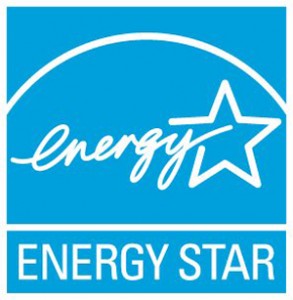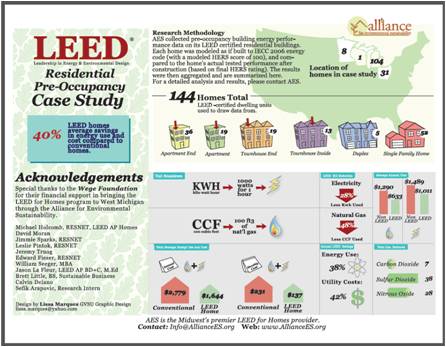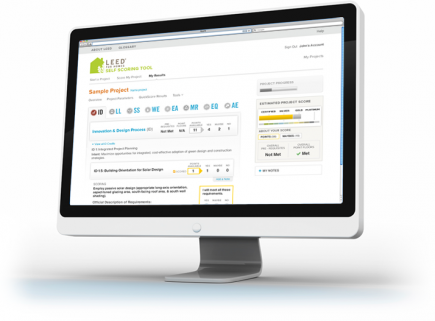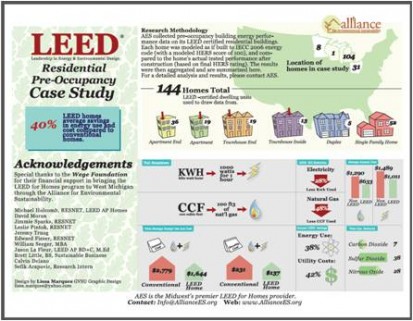Understanding MUEC 2009 and Energy Star V 3.0
/0 Comments/in Education and Events, Illinois, Indiana, Michigan/by Brett LittleDue to the enormous number of questions concerning the updates to Energy Star & the Michigan Uniform Energy Code of 2009, The Green Home Institute has developed a training seminar to answer those questions. This session is meant to help builders; designers and trades contractors understand their options and responsibilities in meeting the requirements of Michigan Uniform Energy Code 2009 which took effect March 9, 2011.
You’ll learn compliance options and contractor/tradesmen responsibilities in meeting the requirements of the code minimum, homebuilder tax credits and Energy Star Version 3.0. With change come opportunities. This 4 hour session may be the most important training you can take this year to help you position your business to meet the requirements currently in place or being introduced January 1, 2012.
The presenter for this seminar is Michael Holcomb, President and founding member of the Green Home Institute. He is a founding member of Green Built™ Michigan Inc., The Home Inspector General Inc, and Michigan Green Building Alliance. Mike is a LEED® AP + Homes and NAHB Green Field Verifier. Mike also is a Program Consultant and Trainer with Green Communities™, LEED® for Homes™, Green Built™ Michigan Energy Star®, Live Green, Live Smart Institute, the American Lung Association Health House®, and he trained over 4,500 architects, designers, and builders throughout the Great Lakes States.
WHO SHOULD ATTEND?
Anyone interested in gaining a better understanding of Energy Star V3 the Michigan Uniform Energy Code 2009
o Architects
o Builders
o Developers
o Sub Contractors
o Engineers
o Code Officials
Friday, May 6th 2011
8:00 a.m. – 12:00 p.m.
MTEC Room ATC 120
622 Godfrey
Grand Rapids, MI 49503
COST –
Early Bird Registration $35.00 per person
Register at the door $50.00 per person
Registration Includes – Breakfast snacks & refreshments.
Please pay via PayPal (You do not need to have PayPal to do this)
![]()
Otherwise please send a check to
947 Wealthy St Se
Grand Rapids, MI 49506
LEED reaches its 10,000th Certified Home
/0 Comments/in Illinois, Indiana, Michigan, Minnesota, Ohio, Tools and Resources, Wisconsin/by Brett LittleMore than 10,000 homes across the U.S. have earned LEED certification through the LEED for Homes program, according to the U.S. Green Building Council (USGBC). LEED-certified home projects span the residential market, from multi- and single-family, to market rate and affordable housing.
“Reaching this milestone signifies the continued transformation of the home building industry towards high-performing, healthy homes that save home owners money,” said Nate Kredich, Vice President of Residential Market Development, U.S. Green Building Council. “Market leaders across the production, multifamily, affordable and custom home segments have recognized that there are green homes, and then there are LEED Homes, and they are acting accordingly.”
LEED for Homes is a national voluntary certification system that promotes the design and construction of high-performance green homes that use less energy and water and fewer natural resources; create less waste; and are healthier and more comfortable for the occupants. Since its launch in 2008, 10,161 homes have certified with over 38,000 additional units in the pipeline.
The 10,000th home to earn LEED certification was Tacoma Housing Authority’s 91-unit development, Salishan 7 in Washington. Salishan 7, built by Walsh Construction Company, is the first federally funded HOPE VI Redevelopment project to achieve LEED Platinum. The project was built within an affordable budget, and was designed to be at least 30% more energy efficient than the average home, effectively removing 27 homes from Tacoma Power’s electrical grid.
“We are proud to be a part of the community of over 10,000 homes that have committed to excellence through the LEED for Homes program,” said Michael Mirra, Executive Director, Tacoma Housing Authority. “Our LEED Platinum housing projects are less expensive to operate and are healthier inside, which means a world of difference to our residents.”
Nationally recognized market leaders such as McGuyer Homebuilders, Inc (production homes) in Dallas, Tex., Fore Property (multifamily) and dozens of Habitat for Humanity affiliates (affordable) are just a few of the organizations committing to LEED certification across the country.
Supporting the growth of the LEED for Homes program is the robust and dedicated network of LEED for Homes Providers; a community of nearly 400 LEED AP Homes credential holders, helping meet the need for knowledgeable green home building professionals; and a growing number of LEED for Homes Green Raters. Additionally, the USGBC recently launched its LEED for Homes Scoring Tool for builders to self-evaluate their home construction projects to see how close they are to LEED certification. This simple web-based application makes the program even more accessible to builders and homeowners.
Work with to help make your next LEED project a success.
LEED Professional Credentials Gain ANSI Accreditation
/0 Comments/in Local, Green Home Institute, Illinois, Indiana, Michigan, Minnesota, Miscellaneous, Ohio, Wisconsin/by Brett LittleLEED Green Associate, LEED AP O&M and LEED AP Homes, among other GBCI-administered credentials achieve recognition from the American National Standards Institute.
“This accreditation from ANSI validates the integrity of our processes under a global standard. That provides a mark of differentiation for our credential holders, and the respect of the market that employs them” said Beth Holst, Vice President for Credentialing at GBCI.
Read the full article here.
What this will do in the marketplace is assure employers that their AP staff are uniquely qualified and trained individuals who are setting the bar for green building by meeting the rigorous demands set by this organization. This will add demand for these credentials amongst employers and add value to those employees looking for a competitive edge in a growing green market.
Especially in a residential green market with an alphabet soup of credentials available under every rating system, having ANSI recognize LEED AP Homes as the “most qualified, educated and influential green building professionals in the marketplace” will not only increase the demand for these LEED AP individuals, but will subsequently increase the demand for their LEED certified homes.
To find other green professionals in your area visit the Green Home Guide, or to learn more about how to become a LEED AP Homes visit our Tools page.
News videos of LEED Gut Rehab
/0 Comments/in Gut Rehab, Illinois, Indiana, LEED Platinum, Michigan, Minnesota, Net Zero, Ohio, Single-Family Projects, Wisconsin/by Brett LittleA recent project in Chicago has garnered national media attention. Here are links to a few of the highlights:
FOX – Chicago
NBC – Chicago
Chicago Magazine posts photos of LEED gut rehab
/0 Comments/in Illinois, LEED Platinum, Net Zero, Single-Family Projects/by Brett LittleChicago Magazine recently profiled a gut rehab home that achieved LEED Platinum certification, and included a photo tour of the Helenowski residence. The home “now energy-neutral or better, meaning it generates enough power to meet its own needs and to sell excess into the power grid.”
Also featured is an affordable green home remodel selling for $150,000.
View details and the photo tour at the Chicago Magazine online blog.
Are you an area professional wanting to earn LEED project experience?
/0 Comments/in Illinois, Indiana, Michigan, Minnesota, Ohio, Wisconsin/by Brett LittleHabitat is pleased to announce its partnership with HabitatPro, a program designed for professionals who are interested in accumulating the now required LEED project experience in order to sit for the LEED AP exams. HabitatPro PX facilitates a rare opportunity to learn LEED by actually doing LEED! Participants will gain “personal involvement” with the LEED project by having the opportunity to be a part of all apsects of the Habitat LEED project including design, construction, documentation and educational development. Participants can expect to receive:
- a personalized letter of attestation from BOULD
- personal hands-on involvement on a LEED registered project
- weekly participation opportunities
- tracked roles and hours via BOULD’s comprehensive database
- partnership with Habitat for Humanity in revitalizing your community
The upcoming project Design Charrette is Monday, March 14. For tuition, participation and registration, please visit GoHabitatPro.com.
(Note, if you can’t make this meeting there are still many opportunities)
LEED Home Scoring Tool Released
/0 Comments/in Illinois, Indiana, LEED Credits, Michigan, Minnesota, Ohio, Tools and Resources, Wisconsin/by Brett LittleUSGBC has created an online tool that will allow anyone to “kick the tires” on taking a single- or multi-family building through LEED for Homes certification. The Online Scoring Tool (OST) is available at no cost through www.leedforhomes.org and provides a great way to evaluate the LEED rating system.
The user-friendly Online Scoring Tool (OST) allows free access to anyone that creates a web site account. Once logged in, people can score multiple rojects using the online scoring tool.
Two Scoring Paths
Projects can choose to take one of two paths with the LEED Homes scoring tool. One path called the Quick Score, allows a builder to answer a green home version of 20 questions about a sample project. Its perfect for a builder that has had a HERS Rating performed on a previous home and is wondering how that home would have scored in LEED. Once the questions are answered, the scoring tool gives an estimate on the potential LEED certification level.
A more advanced path allows the user to go through the LEED for Homes rating system in detail for a specific project, with credit-by-credit analysis. Each credit can be selected as Yes, No, or Maybe. Best of all, the online tool does an impressive job of digesting the extensive LEED for Homes Reference Guide into salient tool-tip help that can be brought up in a popup window. This explanation will help people decide whether or not they want to pursue a specific LEED credit or not.
The LEED for Homes Online Scoring Tool (OST) is available at no cost through www.leedforhomes.org
Post Occupancy Study & Extra ID Credit Opportunity
/0 Comments/in Illinois, Indiana, LEED Credits, Michigan, Minnesota, Ohio, Wisconsin/by Brett Littleis conducting a post occupancy utility study of all our current/future LEED for Homes projects in conjunction with USGBC’s new pre-approved Building Performance Partnership ID credit. This study will help measure the effectiveness of LEED™ for Homes, work as an educational tool and help promote the LEED™ standard and all parties involved in certified projects. We encourage project team leaders to inform residents of this opportunity.
Project teams signing up can earn one Innovation and Design point for enrolling.
Background Information USGBC’s Building Performance Partnership (BPP): engages commercial and residential LEED building owners and managers in an effort to optimize the performance of buildings through data collection, analysis and action. This partnership among USGBC and the thousands of LEED project owners will result in the population of a comprehensive green building performance database, enable standardization of reporting metrics and analytics, and establish new performance benchmarks. USGBC’s BPP participants are eligible for annual performance reports, report cards and real-time data interfaces to aid in their building performance goals. Together, USGBC and BPP participants will transform the way the world views building operations.
Please sign up here below
To earn ID Credit please go to the USGBC’s Website and fill in your project information and check off: 38: PF – Advanced Utility Tracking
Then sign up here. http://www.earthaid.net/bpp
Note: you will need to have an active online account with you utility companies, if you don’t, please sign up (this also a good time to make sure to select the paperless option with your utilities!)
Let us know once you have signed up!
Report Shows Increased Value of LEED Homes
/0 Comments/in Economics, Illinois, Indiana, Michigan, Minnesota, Ohio, Wisconsin/by Brett LittleIn a newly-released report, the Green Home Institute () analyzed data from LEED-certified homes in the Midwest found that the homes averaged 40% less energy use and utility costs annually when compared to conventional homes.

LEED for Homes Case Study Report
From January through June 2010, the Green Home Institute () collected Read more
Menu
GreenHome Institute
GreenHome Institute
ATTN José Reyna
1451 Lake Drive SE, #6484
Grand Rapids, MI 49516
Tel: (616) 458-6733
Email: info@greenhomeinstitute.org
About Us
Recent Posts
- April 2024 GreenHome and Sustainability Jobs Round-Up.
- Protected: Public comment on Inflation Reduction Act Home Rebates opening in MI and beyond
- Shawn Neinhouse completed Certified GreenHome Professional Training
- Please take this MSU Student’s Mass Timber Survey
- Clean Energy Credit Union Clean Energy For All Reduces Barriers





